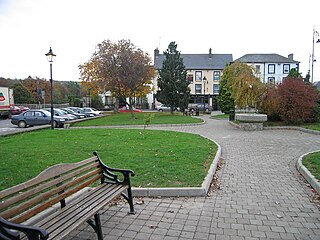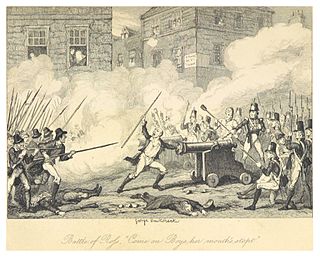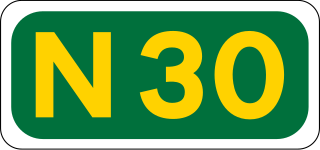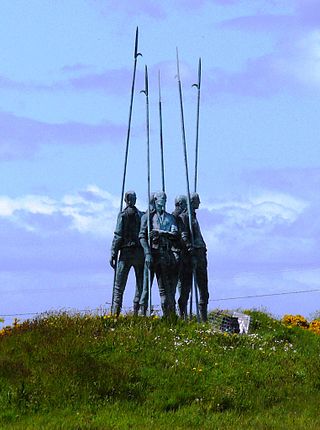
Enniscorthy is the second-largest town in County Wexford, Ireland. The town is located on the picturesque River Slaney and in close proximity to the Blackstairs Mountains and Ireland's longest beach, Curracloe.

Wexford Harbour in County Wexford, Ireland is the natural harbour at the mouth of the River Slaney. In earlier times, the area occupied by the harbour was considerably larger than it is today, up to ten miles (16 km) wide at its widest point, with large mud flats on both sides. These were known as the North Slob and the South Slob from the Irish word slab, meaning mud. It contained several islands, among which the large island of Beggerin was known to be a safe refuge for early Christian settlements.

The River Slaney is a large river in the southeast of Ireland. It rises on Lugnaquilla Mountain in the western Wicklow Mountains and flows west and then south through counties Wicklow, Carlow and Wexford for 117.5 km (73 mi), before entering St George's Channel in the Irish Sea at Wexford town. The estuary of the Slaney is wide and shallow and is known as Wexford Harbour. The catchment area of the River Slaney is 1,762 km2. The long term average flow rate of the River Slaney is 37.4m3/s

Bunclody, formerly Newtownbarry, is a small town on the River Slaney in Wexford, Ireland. It is located near the foot of Mount Leinster. Most of the town is in County Wexford; a small area at the north end of town is in County Carlow. Bunclody has received a number of high scores in the Tidy Towns competition. The town is known for the "Streams of Bunclody Festival" held during the month of July.

The Battle of New Ross was a military engagement which took place in New Ross, County Wexford during the Irish Rebellion of 1798. It was fought between the Society of United Irishmen rebels and government forces garrisoning the town. The attack on the town of New Ross on the River Barrow, was an attempt by the recently victorious rebels to break out of county Wexford across the river Barrow and to spread the rebellion into county Kilkenny and the outlying province of Munster.

The Battle of Vinegar Hill was a military engagement during the Irish Rebellion of 1798 on 21 June 1798 between a force of approximately 13,000 government troops under the command of Gerard Lake and 16,000 United Irishmen rebels led by Anthony Perry. The battle, a major rebel defeat, took place on 21 June 1798 on a large rebel camp on Vinegar Hill and in the streets of Enniscorthy, County Wexford and marked the last major attempt by the rebels to hold and control territory taken in Wexford.
John Kelly lived in the town of Killanne in the parish of Rathnure, west of Enniscorthy, in County Wexford in Ireland, and was a United Irish leader who fought in the Irish Rebellion of 1798. Kelly was obviously well known to rebels and loyalists alike during the short duration of the Wexford Rebellion but almost nothing is known of him outside this time. He was one of the leaders of the rebel victory at the Battle of Three Rocks which led to the capture of Wexford town but was later seriously wounded while leading a rebel column at the Battle of New Ross.

The second Battle of Arklow took place during the Irish Rebellion of 1798 on 9 June when a force of United Irishmen from Wexford, estimated at 10,000 strong, launched an assault into County Wicklow, on the British-held town of Arklow, in an attempt to spread the rebellion into Wicklow and to threaten the capital of Dublin.

The N30 road is a national primary road in Ireland. It connects the N25 road and M11 motorway, providing a link running east-northeast through County Wexford, between New Ross and Enniscorthy. This provides for a more direct national route between the two towns, as the N25 and N11 both run to Wexford town, eastwards from New Ross and southwards from Enniscorthy respectively.

John Murphy was an Irish Roman Catholic priest of the Roman Catholic Diocese of Ferns, who is mainly remembered for his central role in the Irish Rebellion of 1798 in County Wexford, which is sometimes known as the Wexford Rebellion. He led the rebels to one of their initial victories over a government militia at Oulart Hill, and in the following weeks became one of the rebellion's main leaders.
Events from the year 1798 in Ireland.
"Boolavogue" is an Irish ballad commemorating the campaign of Father John Murphy and his army in County Wexford during the Irish Rebellion of 1798. It was composed by Patrick Joseph McCall in 1898, the centenary of the Rebellion.
Beauchamp Bagenal Harvey was a barrister and a commander of the United Irishmen in the Battle of New Ross during the 1798 Rebellion.

The Wexford Rebellion refers to the outbreak in County Wexford, Ireland in May 1798 of the Society of United Irishmen's rebellion against the British rule. It was the most successful and most destructive of all the uprisings that occurred throughout Ireland during the 1798 Rising, lasting from 27 May 1798 until about 21 June 1798. The Wexford Rebellion saw much early success despite County Wexford not being thought of as an immediate threat by the government, because of the spontaneous risings that occurred both before and after the significant rebel victories in Oulart, Enniscorthy, and Wexford town. The rising in County Wexford was eventually defeated by the British authorities following the Battle of Vinegar Hill.
Thomas Cloney was a United Irishman, and leader of the rebellion in County Wexford in 1798, and with Robert Emmet a co-conspirator in the attempt to renew the republican insurrection in 1803.

The Battle of Enniscorthy was a land battle fought during the Irish Rebellion of 1798, on 28 May 1798, when an overwhelming force of rebels assailed the town of Enniscorthy, County Wexford, which was defended only by a 300-strong garrison supported by loyalist civilians. On the previous day at nearby Oulart, several thousand rebels led by Fr John Murphy had massacred a detachment of the North Cork militia, amounting to 110 officers and men.
Philip Roche was an Irish Roman Catholic priest who in the Irish Rebellion of 1798 commanded insurgents in Wexford and was subsequently executed.

Cornelius Grogan (1738?–1798), was a United Irishman and commissary-general in the insurgent army of Wexford in the Rebellion of 1798.
John Henry Colclough was a United Irishman, who was executed in Wexford following the Irish Rebellion of 1798.
Matthew Keogh or Keugh or Keough was the United Irish governor of Wexford during the Irish rebellion of 1798. Held responsible for a massacre of loyalists in the town, he was hanged following its recapture by Crown forces.














